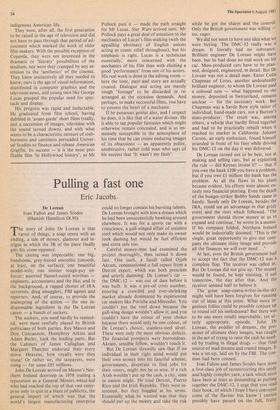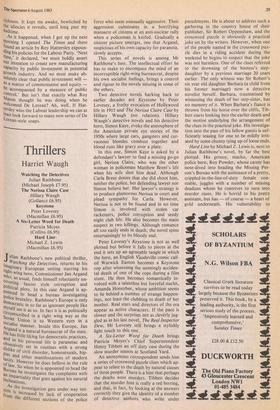Pulling a fast one
Eric Jacobs
De Lorean
Ivan Fallon and James Srodes (Hamish Hamilton £8.95)
The story of John De Lorean is that rarest of things, a soap opera with an ending, a tale of money, glamour and in- trigue in which the JR of the piece finally gets his come-uppance.
The casting was impeccable: one big, handsome, grey-haired smoothie (smooth, at least, on the surface); one beautiful model-wife; one sinister tough-guy en- forcer; assorted flannel-suited worthies engineers, accountants and the like; and in the background, a ragged chorus of IRA terrorists, drug smugglerS, FBI agents and reporters. And, of course, to provide the mainspring of the action — the one in- dispensable ingredient in the De Lorean career — a bunch of suckers.
The suckers, you need hardly be remind- ed, were most zestfully played by British politicians of both parties. Roy Mason and Don Concannon, Humphrey Atkins and Adam Butler, took the leading parts. But the Cabinets of James Callaghan and Margaret Thatcher endorsed their every move. Heavens, how royally were they stung! Or rather we, the taxpayers, were stung — for some £85 millions. John Dc Lorean arrived on Mason's Nor- thern Ireland doorstep in 1978 trailing a reputation as a General Motors whizz-kid who had reached the top of that vast enter- prise only to quit in a blaze of publicity, the general import of which was that the world's largest manufacturing enterprise could no longer contain his bursting talents. De Lorean brought with him a dream which he had been unsuccessfully hawking around elsewhere. It was for a sports car with a conscience, a gull-winged affair of stainless steel which would not only make its owner look dashing but would be fuel efficient and extra safe too.
Careful money-men had examined the project thoroughly, then turned it down fast. One such, a Saudi called Ojjeh Akram, commissioned a full report from a Detroit expert, which was both prescient and utterly damning. De Lorean's car the DMC-12 — was out of date before it was built. It was a pre-oil crisis number, entering a crowded and ever-shrinking market already dominated by experienced car makers like Porsche and Mercedes. You couldn't put the roof down because the gull-wing design wouldn't allow it; and you couldn't have the colour of your choice because there would only be one colour,, of De Lorean's choice, stainless-steel silver. These were only the most obvious defects. The financial prospects were horrendous. Akram, sensible fellow, wouldn't touch it.
But De Lorean shrewdly saw that if no individual in their right mind would put their own money into his fanciful scheme, governments, desperate to find jobs for their voters, might not be so wise. If a rich Arab wouldn't put up the cash, a city, state or nation might. He tried Detroit, Puerto Rico and the Irish Republic. They were in- terested, but they boggled at his terms. Essentially what he wanted was that they should put up the money and take the risk while he got the shares and the control. Only the British government was willing no, eager.
We did not seem to have any idea what we were buying. The DMC-12 really was a dream. It literally had no substance. Brilliant engineer De Lorean might have been, but he had done no real work on his car. Mass-produced cars have to be plan- ned, designed, engineered, in detail. But De. Lorean was not a detail man. Enter Colin Chapman of Lotus, another undoubtedly brilliant engineer, to whom De Lorean paid a colossal sum — what happened to the money, deposited in Switzerland, remains unclear — for the necessary work. But Chapman was a Savile Row style tailor of individual, hand-made cars, not a Burton's mass-producer. The result was, among others; a vehicle that hardly fitted together and had to be practically rebuilt when it reached its market in California. Johnny Carson, an early enthusiast, found himself stranded in front of his fans while driving his DMC-12 on the day it was delivered.
De Lorean turned out to be best, not at making and selling cars, but at exploiting the rule — did Keynes invent it? — that if you owe the bank £100 you have a problem, but if you owe £1 million the bank has the problem. As all the flaws in his plans became evident, his efforts went almost en- tirely into financial plotting. Even the death of the hunger-striker Bobby Sands came in handy. Surely only De Lorean, besides the IRA, could see an advantage in that grisly event and the riots which followed. 'The government should throw money at us to expand and continue,' he wrote in a memo. If his company folded, Northern Ireland would be industrially doomed. 'This is the single, great opportunity to give our com- pany the ultimate shiny image and provide all the finances we will ever need. „ ' At last, even the British government had to accept the fact that the DMC-12 was a complete flop. The receiver was called in. But De Lorean did not give up. The money would be found, he kept insisting, if not tomorrow, the day after that. And the receiver seemed half to believe it.
The great soap-opera-writer-in-the-skY might well have been forgiven for running out of ideas at this point. What more in- genious follies could he possibly conjure up to round off his melodrama? But there was to be one more totally improbable, yet ut- terly appropriate, episode. John De Lorean, the peddler of dreams, the pro- moter of ultimate shiny images, was caught in the act of trying to raise the cash he need- ed by trading in illegal drugs — that final source of mad dreams and crazed images. It was a set-up, laid on by the FBI. The con- man had been conned.
Ivan Fallon and James Srodes have done a first-class job of reconstructing this seedy and highly complex yarn, a task which must have been at least as demanding as putting together the DMC- I 2. 1 urge that you read their book, of which I hope I have conveyed some of the flavour but know I cannot possibly have passed on the full, fruity richness. It kept me awake, bewitched by the idiocies it reveals, until long past my bedtime.
As it happened, when I got up the next Morning I opened The Times and there found an article by Roy Hattersley expoun- ding his policies for the Labour Party. 'Next tittle,' it declared, 'we must boldly assert our intention to create new manufacturing capacity by public investment in potential growth industry. And we must make ab- solutely clear that public investment will as a matter of commonsense and equity be accompanied by a measure of public control.' But isn't that exactly what Roy Mason thought he was doing when he ,welcomed De Lorean? Ah, well. If Hat- tersley wins the Labour leadership we can at least look forward to many new series of De Lorean-style soaps.







































 Previous page
Previous page